Some people think that permissioned distributed ledger technology can perform better than open blockchain because it is tweaked to address the issu

Some people think that permissioned distributed ledger technology can perform better than open blockchain because it is tweaked to address the issues of the latter. Such systems are also called “permissioned blockchain,” as if blockchain is a high-level concept and “permissioned” is one of its variants. But this statement is controversial and down below, you will come to understand why.
Is “permissioned” decentralized?
There are a lot of other options to choose from in DLTs: permissioned, private, enterprise, federated DLT, etc. And frankly, sometimes, it is not easy to distinguish between them. Therefore, for this level of discussion, let us compare just DLTs vs. blockchain.
A permissioned DLT and the mentioned variety thereof are not decentralized. There should not be any fallacy around this, as it might be fatal for a project. While some opponents to this statement might claim that decentralization can have a degree, and of course, permissionless blockchain is more decentralized.
Let us put it simply. If there is someone between two counterparties in a transaction, and you can do nothing about this, it is centralized. In a public blockchain, if an ordinary user does not want to rely on a miner for their transaction to be included in a block, they can draft their transaction, and mine a block themself. If the block is valid, the network will accept it. Of course, mining nowadays requires enormous computational resources, but there are no technical or formal barriers to it — you don’t need to seek permission to mine. In DLT, users of the network have different roles and authority, and ordinary users are not able to create and validate blocks. There is nothing wrong with having a centralized system; it is just a matter of understanding what you are dealing with.
Related: What is the difference between blockchain and DLT?
Permissioned DLTs can be decentralized only from one perspective, i.e., by having a consortium of independent members (organizations, companies, etc.) running the network with the exclusive authority to create blocks. Having a few affiliated companies controlled by one beneficiary will not make it decentralized.
And keep in mind, any consortium structure with independent members can be decentralized but only for these members — it will always be centralized for all those outside of the consortium.
Is DLT a cartel?
A consortium (private/permissioned) DLT can be considered a cartel. Sooner or later, an antitrust body may question this. A safe strategy would ensure that the terms and conditions of the consortium were built in compliance with the antitrust laws.
By the way, to be completely centralized system is much safer. But a centralized system will never achieve the same level of reliability and credibility that blockchain can. It will be vulnerable as any other centralized system is, and here is why.
A centralized DLT is not immutable. The ledger can be rewritten arbitrarily by the one (or more) who controls it or due to a cyberattack. Because of its open and competitive nature (mining, staking, etc.), any blockchain can achieve immutability and hence its records will be credible. Thousands of independent nodes can ensure an unprecedented level of resistance to any sort of attack.
Usually, it comes next after the discussion about immutability. How to correct a mistake? What if you need to change your smart contract? What if you lost your private key? There is nothing you can do retroactively — alteration in the blockchain is impossible. What’s done is done. In this regard, the DLT is usually the opposite of an alternative to blockchain. You will hear that DLTs can be designed so that those who control the network verify transactions on entry and therefore, non-compliant transactions are not allowed to pass through. But it would be a fallacy to think that censorship in the network will ultimately exclude all mistakes and unwanted transactions. There will always be a chance for a mistake. Then what? A retroactive change as the last resort? But if you can alter history, you undermine the whole idea of blockchain. No other technology can ensure such a level of the immutability of data. It is not one of the advantages of blockchain — this is its distinguishing advantage.
Related: Circling back to blockchain’s originally intended purpose: Timestamping
Nevertheless, immutability is perceived as something that impedes its legal application. Say, your circumstances changed, and you need to alter the smart contact. The answer to this is the proper design of an application that does not undermine the immutability of the ledger. The smart contract should be designed in a way that the user can attach a new transaction to reflect a change toward the previous one. Blocks are firmly chronological and only the latest transaction will reflect the current state of affairs, while all previous transactions will be a historical reference. You don’t need to change history. The blockchain is…
cointelegraph.com
